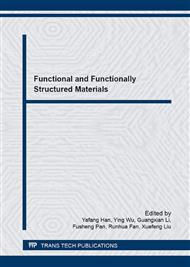p.494
p.498
p.505
p.519
p.527
p.532
p.538
p.543
p.551
Reduction-Degradable Shell Cross-Linked Micelle with pH-Responsive Cores Prepared via Click Chemistry
Abstract:
A well-defined poly [(ethylene glycol)-block-2-(dimethylamino) ethyl methacrylate-block-2-(diethylamino) methacrylate] (PEG-b-DMA-b-DEA) triblock copolymer was synthesized via atom transfer radical polymerization (ATRP) by successively polymerization of DMA and DEA monomers using a PEG-based macroinitiator, and obtained copolymer was then converted to be PEG-b-P(DMA-co-QDMA)-b-PDEA copolymer with “clickable” moieties in the middle block by the quaternization with propargyl bromide. Those copolymers prepared were characterized by proton Nuclear Magnetic Resonance (1H NMR) and Gel Permeation Chromatography (GPC), and its self-assembly behavior and subsequently fixation with bis-(azidoethyl) disulfide via click chemistry resulting reduction-sensitive shell-cross-linked (SCL) micelle in purely aqueous solution were investigated by Transmission Electron Microscopy (TEM) and Dynamic Light Scattering (DLS). The results show the micellar structure could be effectively cross-linked via click chemistry and also be dissociated at reduction condition, which may realize it's potential application as novel drug delivery carriers.
Info:
Periodical:
Pages:
527-531
Citation:
Online since:
March 2016
Authors:
Price:
Сopyright:
© 2016 Trans Tech Publications Ltd. All Rights Reserved
Share:
Citation:


